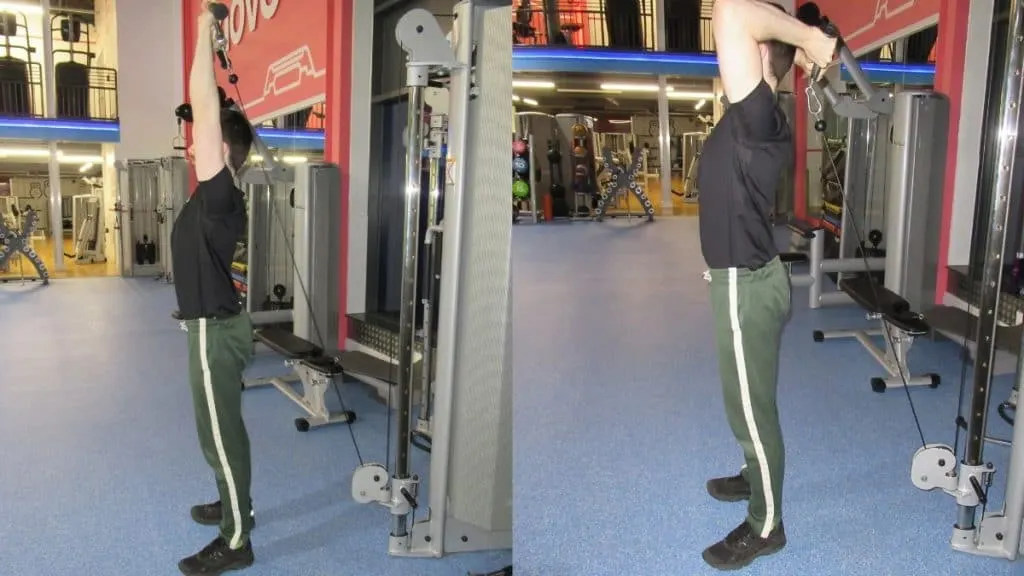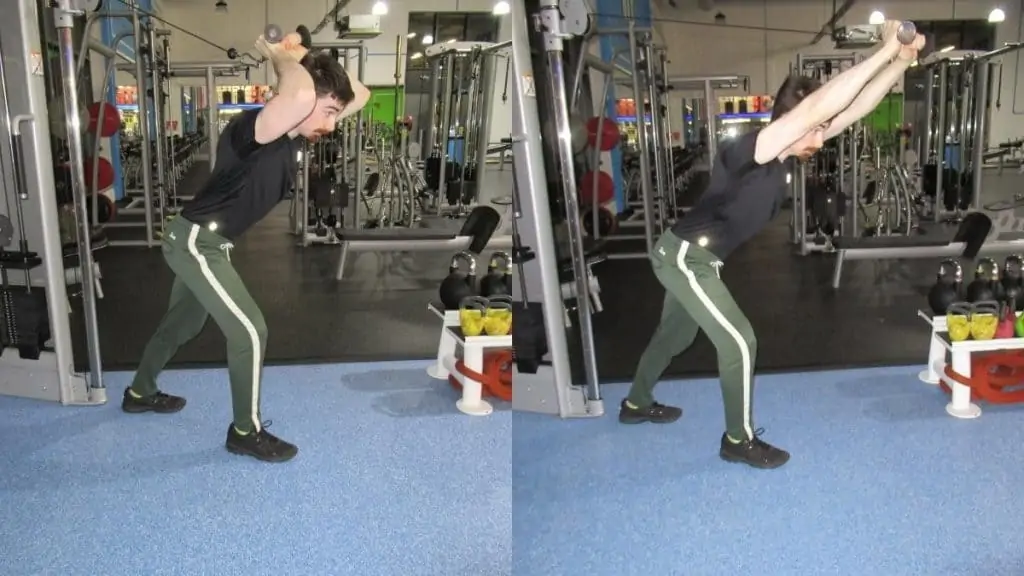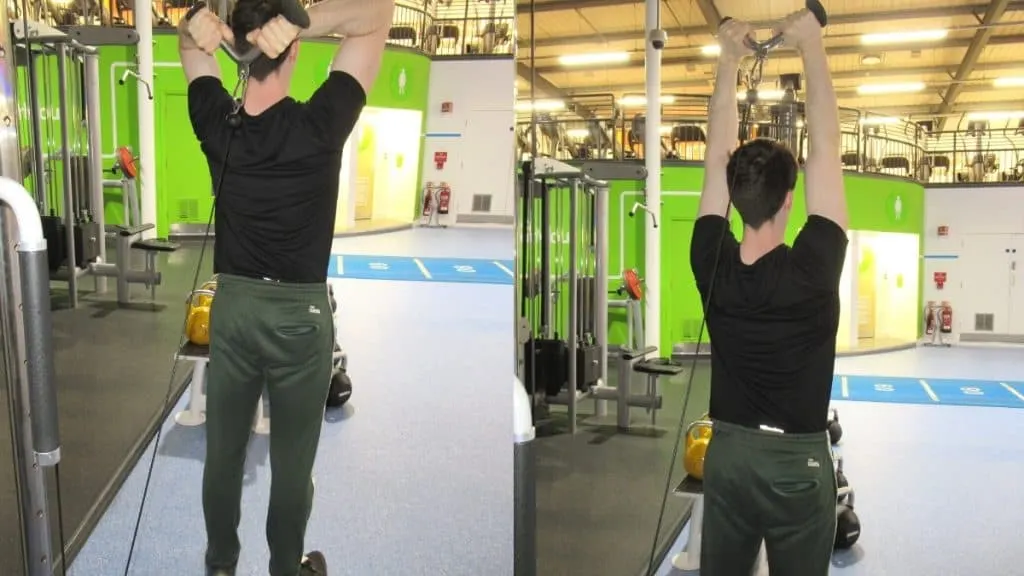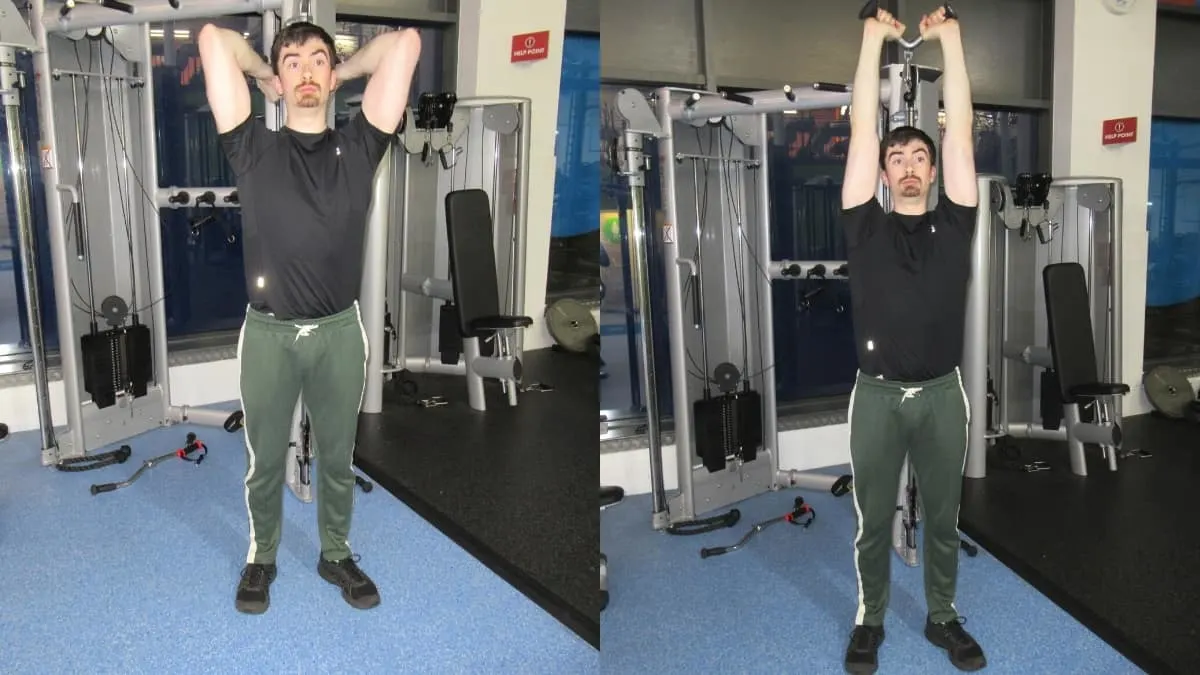What is a tricep for if not lifting heavy weights? The triceps brachii, after all, has the highest proportion of fast-twitch (type 2) muscle fibers of any muscle group in the human body. This means that the triceps respond exceptionally well to low reps, heavy loads, and explosive lifting.
Free weights are excellent training tools for the triceps in this regard because they enable you to overload the target muscles with substantial amounts of resistance. The issue with most free weight lifts is that they don’t challenge your triceps with constant tension like the overhead rope extension.
Since your triceps only respond to tension (they don’t know what ‘weight’, ‘pounds’, or ‘kilos’ are), it makes sense to perform exercises that tax your tris with consistent resistance throughout the full range of motion.
V bar overhead tricep extensions are a reliable choice here because the exercise works the biggest head of the triceps (the long head) while pumping up your arms with constant cable tension. In other words, you don’t have to choose between building mass and getting a great pump when you do overhead v bar extensions.
Related Exercise: v bar pushdown
V bar overhead tricep extensions exercise details
- Main Muscles: Triceps
- Exercise Type: Strength
- Exercise Mechanics: Isolation
- Difficulty Level: Intermediate
- Equipment Needed: Cable station, v bar attachment
How to do v bar overhead tricep extensions

- Position a cable pulley at around hip height and connect a v bar attachment. If the pulleys on your machine aren’t adjustable, then just use the low pulley.
- Grab the v bar and then, in one swift motion, turn away from the machine and move the attachment behind your head.
- Ensure that your feet are planted firmly on the ground, but don’t lean forward; either take a slightly staggered stance or keep your feet hip-width apart.
- Brace your core and tuck your elbows in slightly.
- Flex your triceps to extend the v bar over your head. Keep going until your elbows are locked out.
- Squeeze your triceps forcefully at the top of the rep.
- Lower the bar behind your head under control; keep going until you feel an intense stretch in your triceps.
- Repeat for 3-5 sets of 8-20 reps.
Variation: Leaning overhead v bar extensions

If you struggle to get your arms all the way behind your head during overhead v bar tricep extensions (which you need to do in order to get a proper triceps stretch), then you can give the leaning variation a go instead.
In this version of the v bar overhead extension, you’re going to put the pulley at hip height and then take a staggered stance. Many tutorials recommend using the low pulley for any kind of overhead v bar extension or incline cable tricep extension.
However, using a low pulley makes it harder to get the bar behind your head and requires a lot more core strength, both of which can detract from the quality of work that your triceps receive (due to the fatigue and exertion from getting the bar into position). As such, your best bet is to use an adjustable cable machine and put the pulley somewhere around waist height or hip height.
In the leaning v bar overhead tricep extension, you need to bend over at your waist once you’ve got the bar behind your head. See which torso position provides the best triceps stretch and contraction for your build. Most lifters bend over to around 45 degrees, but you might get a better workout by bending over to 90-degrees and making your torso parallel with the floor.
Once your body is in the proper position, you simply flex your triceps to move the v bar forward. After your elbows reach full extension, release the contraction in a controlled manner and bring the bar behind your head so that your triceps receive a full, deep eccentric stretch.
How effective is the overhead v bar tricep extension for building muscle?

Like the seated cable extension (which you can also do with a v bar), the overhead v bar tricep extension is effective for two main reasons.
First off, overhead v bar extensions train all three tricep heads while emphasizing the largest of those heads, namely, the long head. Since the long head is bigger than the lateral and medial heads combined, it’s the single biggest muscle in your upper arm. Thus, its development is of paramount importance for gaining arm mass and triceps strength.
Yet, to work the long head optimally, you have to put your shoulders into flexion in order to provide it with a growth-stimulating eccentric stretch. Since the v bar overhead extension puts your shoulders into maximum flexion (if you can get your arms all the way behind your head), it’s naturally an excellent exercise for growing your triceps.
Unlike free weight movements, the v bar overhead tricep extension also challenges your tris with constant tension. This is because once you lift the weight off the stack, your triceps have to handle the tension because the pulley is always trying to move the weights back down. So even when your elbows are locked out during the v bar overhead extension, your triceps still have to contract against the constant tension of the cables.
Are there any downsides of using a v bar for overhead extensions?

Like any kind of bar, v bars force your wrists into a fixed position, which, on its own, isn’t enough to cause any sort of discomfort. However, when you add heavy resistance levels into the mix, it’s possible that you might feel some strain on your wrists.
V bar attachments also tend to force you into using a very narrow hand position, which, again, can put your wrists in a rather unnatural position.
Unlike straight bar attachments, however, v bars typically enable you to keep your wrists in a joint-friendly neutral position, which is widely considered the safest position to keep your wrists in during resistance training.
Ultimately, the only way to see whether your joints can handle v bar overhead extensions is to hit the gym and perform the exercise yourself. Using a controlled lifting tempo, however, will undoubtedly help to keep the tension on your muscles rather than on your joints.
Read More: Kneeling cable triceps extensions
Conclusion
V bar overhead triceps extensions are a tremendous muscle-building exercise because they tax your triceps with relentless resistance while training the all-important long head in an optimal fashion.
Overhead v bar triceps extensions are also a remarkably versatile exercise. You can do them for sets of 15-20 reps to pump up your triceps after a heavy workout (a great way to accumulate plenty of training volume quickly). Or, you can perform sets of 8-12 reps to generate the heavy mechanical tension that will tear down the muscle fibers and make them grow back bigger and stronger.
Just make sure to get a full stretch and complete contraction on every rep. Using an extensive range of motion is more important for hypertrophy than lifting heavy weights, so be sure to bring the v bar behind your head until you feel a deep stretch in your triceps. After that, flex your triceps until your elbows reach full extension (elbow extension is, after all, the primary function of your triceps).

